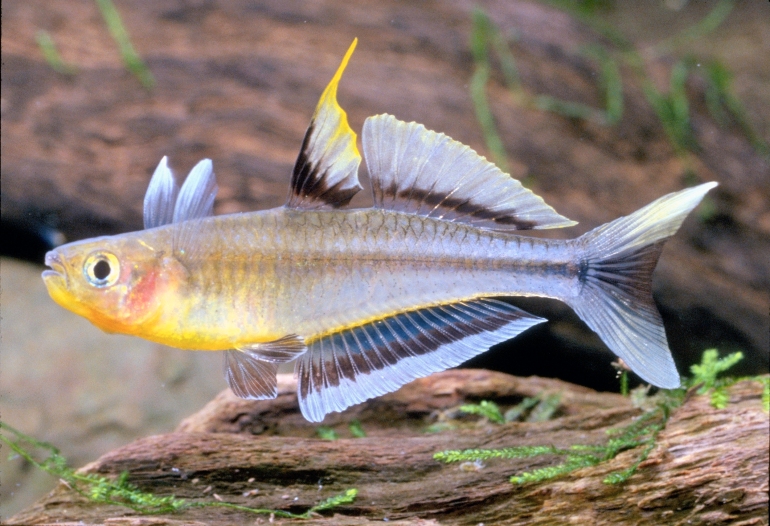|
 |
Pseudomugil connieae - photo© Gunther Schmida |
(Allen, 1981)
Popondetta Blue-eye
Species Summary
When Pseudomugil connieae were initially discovered they were mistakenly identified as Pseudomugil furcatus, a species described by Nichols in 1955, and later placed in a new genus called Popondetta. However, when Gerald Allen realised that they were a new species he called them Popondetta connieae after his wife Connie (Lagos) Allen. When it was discovered that the genus Popondetta already existed, he renamed them Popondichthys connieae. However, in 1989 they were placed in the genus Pseudomugil, where they remain today.
Males are easily distinguished from females by their brighter colours and longer and more elongated dorsal fin. The body colour is yellow-green in both males and females. The dorsal and anal fins of the males have a broad white or yellow outer margin and black band across the middle. The outer region of the first dorsal fin is yellow. Females are similarly coloured but not as intense, and have much smaller fins, which lack the detailed markings of the males. They have a moderately compressed and elongated body and grow to a length of around 5 to 6 cm.
Distribution & Habitat
Pseudomugil connieae were initially collected in 1978 from Auga and Avindo Creeks, in the vicinity of Popondetta, situated on the northern side of the central dividing range, eastern Papua New Guinea. They are common in the vicinity of Popondetta and have been collected from a number of localities within a 25 km radius. They are generally found in small, clear, relatively swift-flowing freshwater streams. Temperature and pH in these streams range from 24-27° Celsius and 7.7-7.9. However, in 1982, Heiko Bleher reported that he had collected them in brackish water in the lower section of the Popondetta River.
Remarks
This species was first collected by Gerald Allen and Brian Parkinson in 1978. They collected approximately 200 specimens. However, mortalities were high and only eight specimens survived the journey back to Australia. Small numbers were eventually bred and circulated in the Australian hobby. However, they were never readily available in the hobby and this small group formed the base of all populations in Australia, which I might add has now almost disappeared. Heiko Bleher collected live specimens in 1982 and these were bred and distributed in Europe and form much of the available stock currently in Europe. I first obtained stock in 1992 and first bred them in January 1993. Some of these were sent to Europe in 1994, which at the time there wasn't many available in Europe.
Pseudomugil connieae are a magnificent blue-eye and are much sought after by aquarium hobbyists. It is very important to provide regular partial water changes as I have found this species doesn't like old, acidic water. The key for successfully maintaining Pseudomugil connieae in captivity is excellent water conditions. This can be easily provided with regular partial water changes. They will display their best colouration when maintained in a densely-planted, partly shaded aquarium. However, this is not a requirement for their successful maintenance in captivity. I have bred and raised them in captivity with the following water conditions: Temperature 19-31°C, pH 7.6-8.2, Hardness 90-150 mg/L, Alkalinity 40-65 mg/L and Conductivity 369-663 µS/cm. I am sure that you will find that most domestic water supplies that are suitable for human consumption will be adequate for the continual maintenance of this species in captivity. Eggs adhere to water plants and hatching occurs around 15 days at a temperature of 25° Celsius. The stomach content of several wild-caught specimens indicated a diet consisting primarily of minute crustaceans and insect larvae with small amount of algal matter.
Literature
Allen G.R. (1981) Popondetta connieae, a new species of rainbowfish (Melanotaeniidae) from Papua New Guinea. Revue française d'Aquariologie 8 (2): 43-46.
Allen G.R. (1987) Popondichthys, a replacement name for the melanotaeniid fish genus Popondetta. Japanese Journal of ichthyology 33 (4): 409.
Allen G.R. (1991) Field guide to the freshwater fishes of New Guinea. Christensen Research Institute, Madang, Papua New Guinea.
Crockford B. (1984) The genus Popondetta. Fishes of Sahul 2(2): 66-68.
Adrian R. Tappin
Updated December, 2008



|

